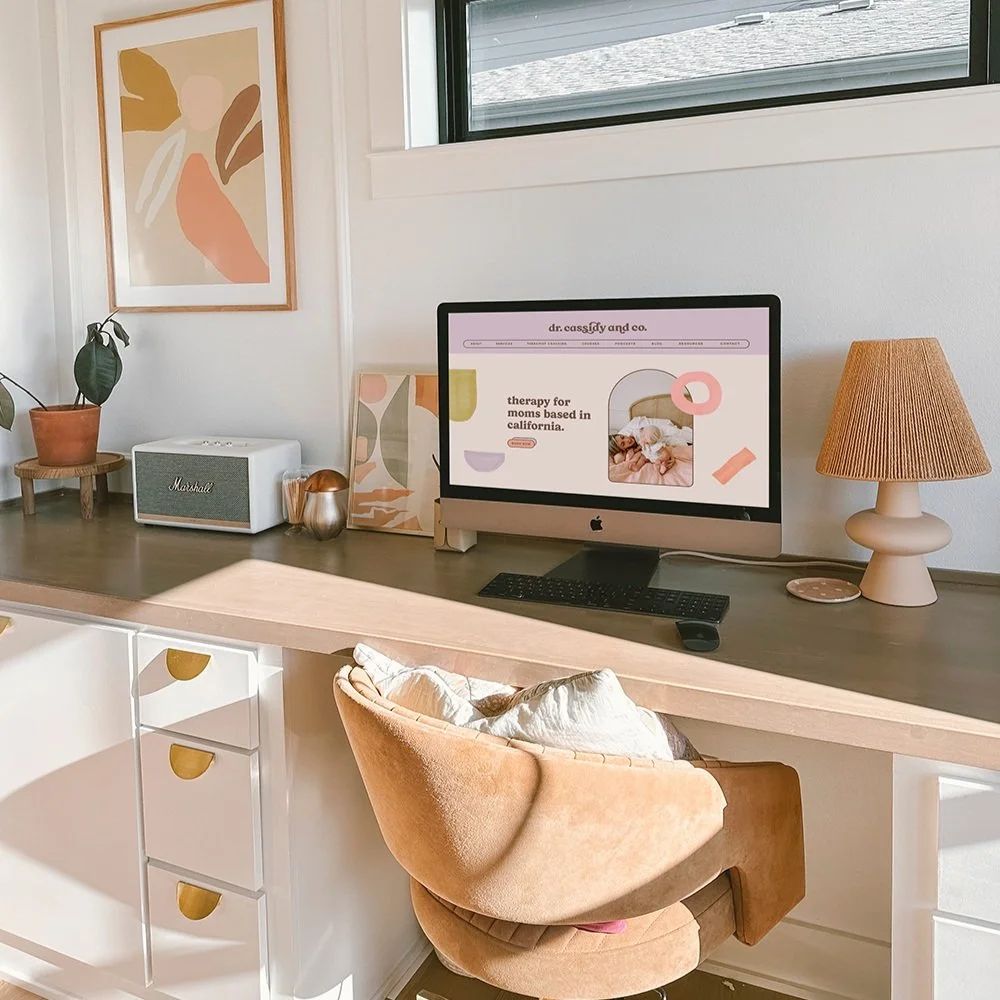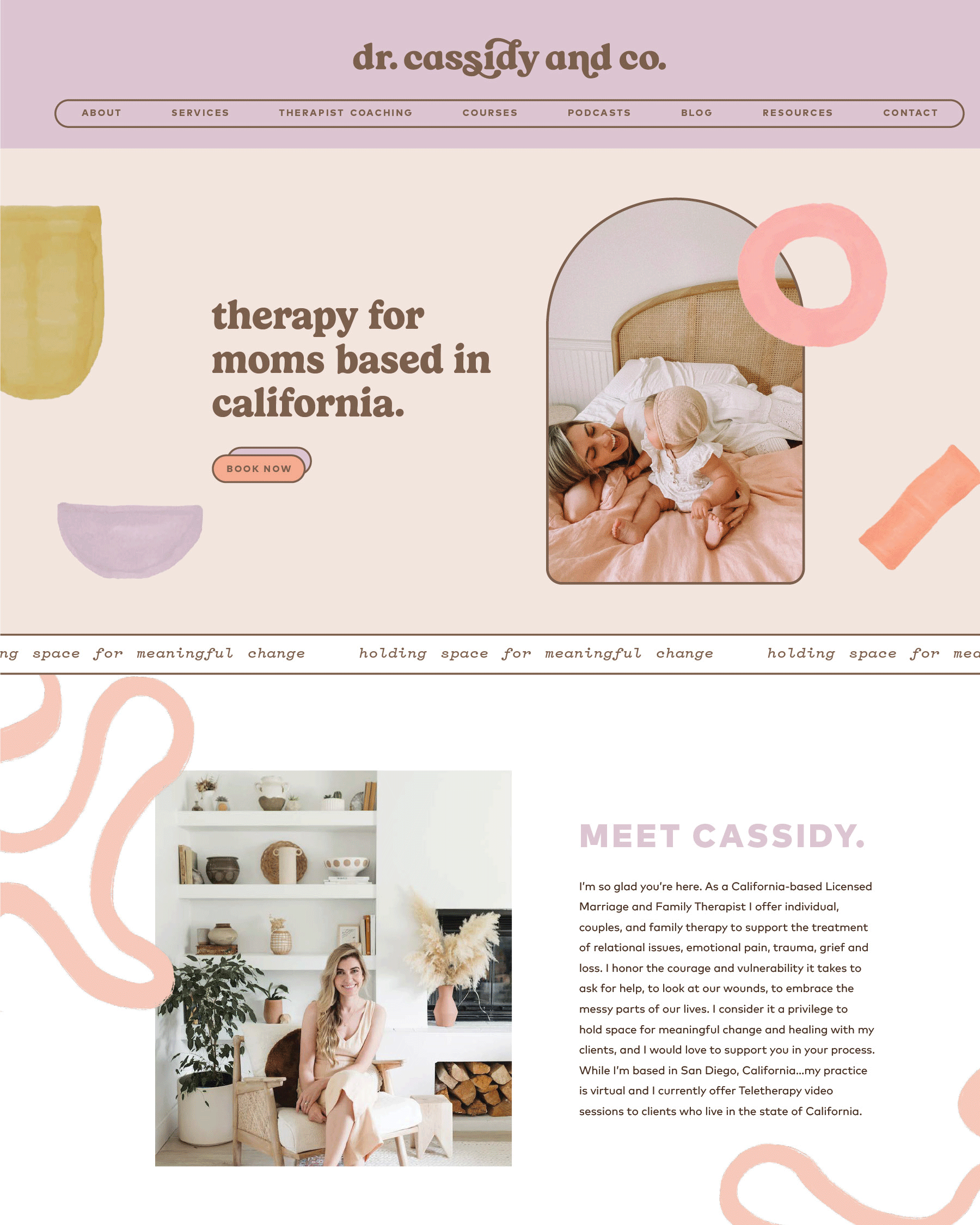How to Optimize Your Website Content
6/12/24
web design
how to optimize your website content
you have seconds to capture someone’s attention — make it count.
Impressions are everything. In this day and age optimizing your website isn’t something to just put on the back burner and make time for eventually. Instead, every business owner should invest time and money into it. You might be thinking, “Okay but why, does it really matter!?” And the answer is 100% yes, yes it does. With 34% of shoppers shopping online at least once a week[1] and the number of online purchases continuously growing year after year[2], having a strong website design AND strong, optimized website content is crucial to a business's success.
This data, while geared more toward my e-commerce homies, can be invaluable to my service-based girlies, too. Think, any consumer looking for a product or service is likely taking the same steps. They’re going online to do the research, finding the best option, and making a purchasing decision whether that be ‘adding to cart’ or inquiring to work with you. Let’s take it one thought further. Not only is strong site content important to help consumers make a purchasing decision but it’s SO important for SEO, too! Think of a local coffee shop. If they don't have a website, they're not popping up in search results when someone Googles “coffee shop near me”. You simply cannot rely on social media which you don't own to do your marketing work for you!
Okay, now that we’ve laid that groundwork and I have you convinced that websites are of the utmost importance let’s throw onnnnne more fact out there. Are you ready!? 96% of the people visiting your website aren’t ready to make a purchase.[3] So what the heck do we do then…? We optimize our website content to first and foremost target our ideal audience and from there, we begin providing them with VALUE. We make an impression, we make sure that 4% make a purchase, and then we leave the 96% eager to come back and engage with us for more.
Content Planning
A website is only successful when strategic design and content come together to help share your story! Every element on your website is considered content — text, photos, products, and even your site navigation. With that, each and every piece of content is an opportunity to speak to your target audience and make an impact. This means selecting images strategically, planning out your site copy, designing an intentional and engaging navigation, and opting for high-quality product photography instead of iPhone shots just to name a few!
Your site content will demonstrate how you’re different from the thousands of others in your industry and help you successfully market your products and services. As you work through your site content keep in mind:
Page Purpose — Each page should serve a purpose whether that be helping to explain to others who you are, how you’re different, or the value you provide.
Keywords — Think about a few keywords you may want to include within your copy for each page. Search engine optimization (SEO) plays a big role in whether people find your site or not so it’s important to think about keywords that people may use when looking for your services and work to include those (naturally!) in your copy.
Imagery — Images will make or break your website. Start brainstorming the photos you want to include within each page to help tell your story. If you’re an e-commerce biz, we shared our top product photography tips in this blog post.
Call to Action — Each page should have its own call to action. That doesn’t mean you need every page linking to your contact page (and we don’t recommend that!), but you don’t want to lead visitors down a dead end either! For site visitors who are on your about page, consider inviting them to learn more about what you offer by visiting the services page.
Homepage
In continuing with some hard truths, it takes a site visitor .05 seconds to form an opinion about your website[4] and that split-second opinion is the difference between someone staying or leaving. Your homepage is likely the first and sometimes only touchpoint your audience has with your brand so creating an engaging page design that sets a stellar first impression is crucial. Your homepage sets the vibe for your whole website. It sets the tone for your brand both with site copy and visuals, should capture your audience’s attention, and encourage them to explore the site further. No pressure!
To make the most of your homepage consider the different pieces of content and elements that will be present.
Your Logo Design — It’s step numero uno. I might sound like a broken record at this point but your website is only going to be as good as your branding. Your logo needs to be well-designed for ALL purposes and your website is just another place and reminder that you need a logo that is representative of your brand and crafted with your target audience in mind. Your logo is going to help draw your ideal customer or client in by giving them a visual representation of your website and therefore your brand too.
Your Navigation — Your navigation is your audience’s guide to your site. It helps map out what’s what and helps them determine where they need to go. With that being said, it’s best to keep your navigation titles simple and effective, think about contact, shop, portfolio, blog, etc. While you should keep these easy to understand, there’s also a beautiful opportunity here to infuse some of your brand personality. As an example maybe your brand is more upscale so inquire feels more on-brand than contact. Instead of ‘about’ maybe you want to use ‘our story’ to feel more personalized. You have a chance here to further your brand voice so don’t waste it!
Your Tagline — We lovvvvve a good tagline. We even offer brand messaging to help you come up with one but when it comes to your above the fold content you want to make sure you’re not just using a tagline that aligns with your brand voice and vibe but that you’re offering valuable information too. When it comes to SEO it’s great to include a keyword here (in a way that feels natural!) and a one-sentence description or value prop. What is it that you offer or do better than anyone else? When a visitor first lands on your site, they should immediately understand who you are and what you offer.
An Incentive Offer — While a special offer isn’t a must-have it’s another opportunity to encourage someone to explore your site and learn more about a particular thing. This could look like offering free shipping, a limited-time webinar, or a special sale. We personally love using an announcement bar for this info as it will capture your audience’s attention without taking up a ton of valuable space in the header.
When planning the rest of your homepage content, you want to think through the user experience and the user journey you want to take your audience through. A few other sections to consider including on your homepage are a services or product overview, portfolio or best seller highlights, an about section, testimonials or credentials, and consider a newsletter sign up or prompt for a freebie (if you haven’t heard, freebies are my favorite way to generate leads and buzz around your business!).
The Importance of the About Page
While your homepage takes top priority for content optimization that doesn’t mean you can slack on other pages. Your about page is another page that deserves lots of love. This is where you can share all the things about who you are, why you started your business, your vision, values, and expertise. I think more often than not it’s easy for people NOT to put a ton of weight or prioritization into this page but the truth of the matter is it’s often the second most viewed page on a website (after the homepage of course!) aka don’t have an about page with a single sentence or paragraph on it.
While your about page is all about you, consider what your target audience wants to hear. If they’re coming to you for your professional services they might want to hear about your background, credentials, or your founder's story. If they’re coming to you to buy products, they might want to know your why, how you got started, and the story behind your products. The goal is to leave your audience feeling connected to you and inspired to buy from you or try your service.
Here are a few content ideas for your about page:
Brand Information — What does your business do, offer, or care about?
Your Story — Every brand has a unique story. Share who you are as an individual (passions, struggles, triumphs) and your background. Why did you get started in the first place and what do you love beyond your business? Your goal is to create an emotional connection to your audience.
Your Team — If you have a team helping you, share about them! This can be a great opportunity to infuse more of your brand personality into your website by highlighting more light-hearted, fun bios or keeping things more formal by sticking to the credentials, expertise, and dedication of your team members.
Core Values — If you’re a service-based business your core values are likely something you want to see reflected in your target client. Sharing the values that guide your company and work can resonate with your ideal client or customer and help create a more meaningful connection and therefore more trust.
Additional Considerations
While we’ve covered two of the most important pages for your website there are a few other pages you’ll want to make sure are optimized before you launch. If you’re a service-based business your services page is going to be just as important (maybe even more!) as your about page. Be sure to include detailed information about your services so that your audience has a good idea of what you offer and how it will benefit them. Plus, where to get in touch! Consider highlighting key challenges your audience might have, your service offerings, the results they can expect, an overview of your process, testimonials and work examples, and of course an all-important call to action.
Every brand is unique and because of that, every site is too! The pages you need to tell your story and communicate what you offer vary based on your audience and the type of products or services you sell. While a homepage, about page, and contact page are must-haves for any website, a few other pages to consider are:
An FAQ page (a great opportunity for SEO!)
A blog
Course pages
A podcast page
A press or media page
An events or workshops page
Commerce pages — shipping, delivery, returns, size guide, etc.
Legal pages — terms and conditions, privacy policy, etc.
There are SO many ways to optimize your website content to connect with your target audience and it can feel overwhelming. The main thing to keep in mind is you’re not making decisions for yourself. You want to think through how site visitors will engage and absorb your content first and foremost, and make decisions based on the customer journey and your goals for the site. And with anything, a great website takes time! If your site isn’t converting leads to customers begin brainstorming the changes you can make and start working through them. Spoiler alert: branding might be the answer and first step!



